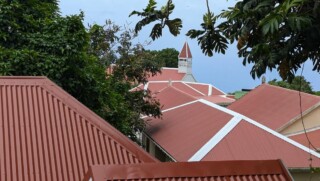The Netherlands Authority for Consumers sets maximum rates for drinking water and electricity
KRALENDIJK – The Netherlands Authority for Consumers & Markets (ACM) has established the 2023 maximum rate for electricity and drinking water on the islands.
The ACM does this yearly, and ensures that the productions companies have sufficient financial power to invest in developing sustainable electricity and drinking water production. This is important, as major sustainability projects have been scheduled on all of the islands for 2023 and beyond.
In the ACM’s view, sustainable production of energy and drinking water on Bonaire, Saba and St Eustatius is not only good for the climate, it also ensures energy and drinking water rates on the islands are less dependent on turbulent global fuel prices.
The ACM sets these maximum rates based on the costs incurred by the production and distribution firms. Due in part to the rise in fuel prices, the maximum rate for electricity and drinking water on Bonaire, Saba and St Eustatius will rise slightly as of the 1st of January 2023. However, in practice, consumers will pay less for water and electricity as the Ministry of Economic Affairs and Climate Policy and the Ministry of Infrastructure and Water Management have promised substantial subsidies. The ministries promised that consumers would not have to pay any of the fixed costs for electricity grid management in 2023, known as the standing charge. In other words, consumers will pay no fixed costs whatsoever, and the only bills they will pay will be based on the variable amounts of electricity consumed. Furthermore, a 50% subsidy will apply to any proportion of the variable costs that exceeds USD 0.38 per kWh. In 2023, drinking water rates will also be subsidised based on the BES Temporary Subsidy Scheme 2018-2024.
Bonaire
On Bonaire, the maximum consumer rate for electricity will rise from around USD 0.42 per kWh to around USD 0.43 per kWh. In practice, however, the subsidies mean that the actual maximum rate for consumers will be around USD 0.41 per kWh. The standing charge for electricity will be fully subsidised, so consumers will not be required to pay anything for their electricity connection in 2023. All of this means that as of the 1st of January 2023, consumers will pay an electricity bill of around USD 85 per month after the subsidy has been taken into account (based on average consumption of around 210 kWh per household).
The maximum rate for the Pagabon (pay as you go) will increase from around USD 0.63 per kWh to around USD 0.68 per kWh. The subsidies also apply to this rate, meaning the actual maximum rate will be around USD 0.41 per kWh.
The maximum rate for drinking water will rise from around USD 3.74 per m3 to around USD 3.91 per m3. This means that the water bill for an average household will rise by around USD 1.70 per month. The standing charge for a household will rise from 41.24 USD per month to 43.96 USD per month. To these amounts subsidies will apply to lower the actual amounts on the invoices.
Saba
On Saba, the maximum consumer rate for electricity will decrease from around USD 0.52 per kWh to around USD 0.43 per kWh. In practice, however, the subsidies mean that the actual maximum rate for consumers on Saba will be USD 0.41 per kWh. The standing charge will also be fully subsidised. All of this means that as of the 1st of January 2023, consumers on Saba will pay an electricity bill of around USD 85 per month after the subsidy has been taken into account (based on average consumption per household).
St Eustatius
On St Eustatius, the maximum consumer rate for electricity will rise from around USD 0.43 per kWh to around USD 0.50 per kWh. In practice, however, the subsidies mean that the actual maximum rate for consumers will be around USD 0.44 per kWh. The standing charge for electricity will be fully subsidised, so consumers on St Eustatius will not be required to pay anything for their electricity connection in 2023. All of this means that as of the1st of January 2023, consumers will pay an electricity bill of around USD 92 per month after the subsidy has been taken into account (based on average consumption per household).
The maximum rate for drinking water will decrease from around USD 8.62 per m3 to around USD 5.79 per m3. This means that the water bill for an average household will decrease by around USD 28 per month. The standing charge for a household will rise from 93.76 USD per month to 98.78 USD per month. To these amounts subsidies will apply to lower the actual amounts on the invoices.
How does the ACM set the maximum rates?
Every year, the ACM sets the maximum rates based on the costs that the production and distribution companies expect to incur during the process of providing energy and water. For this purpose, the ACM continuously examines the actual and expected expenditure of these companies and evaluates these costs based on criteria such as necessity. ACM determines the expected costs based on the investments planned by these companies. The ACM also incorporates these plans into its investigations and evaluations.
In order to stimulate the companies to operate as cost-effectively as possible, the ACM operates based on a profit-sharing scheme. This means if a company manages to spend less than it has budgeted for, then the company is allowed to keep half of the savings for itself as a reward. However, if the costs are higher than forecast, then the company will only be 50% compensated for this overspend via the rates. The ACM will incorporate the bonus/penalty for any given year into the maximum rates for the subsequent year.
What causes the maximum rate for electricity and drinking water to rise or fall?
Although increases or decreases in the maximum rate are generally caused by multiple factors, the main cause is usually developments in international fuel prices. This is because the cost of producing electricity and drinking water on the BES islands is heavily dependent on the development of fuel prices.
In addition, planned investments play a key role as projects such as new pipelines or installations generally require major investments that make up a substantial proportion of the total costs. The latter aspect is partly due to the small-scale production and distribution activities on the BES islands and their isolated location. As a result, all investments are relatively large and consumers notice this via their electricity bills.
One-off corrections from previous years also affect rates on the islands. One important example of these is the profit-sharing scheme described above. Furthermore, companies sometimes appeal successfully against decisions made by the ACM, which often has a material impact that is incorporated into rates for subsequent years.
In short, rises and falls in the maximum rates are usually caused by a combinations of factors, although international fuel prices remain the most important factor.
What developments in the maximum rates are expected in the period after 2023?
This is difficult to predict, as the cost of generating electricity on the BES islands still heavily dependent on developments in international fuel prices. The same applies to drinking water, as this process consumes electricity.
For this reason, the ACM believes that it is important that the generation of sustainable electricity in the BES islands should be maximised as quickly as possible, e.g. by increasing the percentage of solar and wind power. Not only is this important for the climate, but it will reduce the islands’ dependence on turbulent fuel prices, resulting in more stable rates for consumers.
Are producers and distributors able to set prices below the maximum permitted rates?
The rates charged to consumers are determined by the producers and distributors themselves. However, they are not allowed to set rates any higher than the rate caps established by the ACM.
For the time being, the Ministry of Economic Affairs and Climate Policy and the Ministry of Infrastructure and Water Management are subsidising rates on the BES islands. These subsidies are paid to the producers and distributors and consumers benefit from them in the form of lower rates. As a result, the rates charged to low-volume consumers in particular have generally been below the maximum permitted rate.
As these maximum rates are established based on the costs that the producers and distributors are expected to incur in order to ensure continuity of supply, so far it did not happen often that rates actually charged are less than the maximum rates minus the subsidies.












